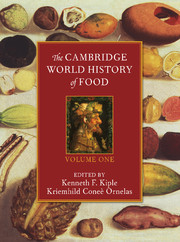Book contents
- Frontmatter
- Introduction
- Part I Determining What Our Ancestors Ate
- Part II Staple Foods: Domesticated Plants and Animals
- II.A Grains
- II.B Roots, Tubers, and Other Starchy Staples
- II.C Important Vegetable Supplements
- II.D Staple Nuts
- II.E Animal, Marine, and Vegetable Oils
- II.E.1 An Overview of Oils and Fats, with a Special Emphasis on Olive Oil
- II.E.2 Coconut
- II.E.3 Palm Oil
- II.E.4 Sesame
- II.E.5 Soybean
- II.E.6 Sunflower
- II.F Trading in Tastes
- II.G Important Foods from Animal Sources
- Part III Dietary Liquids
- Part IV The Nutrients – Deficiencies, Surfeits, and Food-Related Disorders
- References
II.E.5 - Soybean
from II.E - Animal, Marine, and Vegetable Oils
Published online by Cambridge University Press: 28 March 2008
- Frontmatter
- Introduction
- Part I Determining What Our Ancestors Ate
- Part II Staple Foods: Domesticated Plants and Animals
- II.A Grains
- II.B Roots, Tubers, and Other Starchy Staples
- II.C Important Vegetable Supplements
- II.D Staple Nuts
- II.E Animal, Marine, and Vegetable Oils
- II.E.1 An Overview of Oils and Fats, with a Special Emphasis on Olive Oil
- II.E.2 Coconut
- II.E.3 Palm Oil
- II.E.4 Sesame
- II.E.5 Soybean
- II.E.6 Sunflower
- II.F Trading in Tastes
- II.G Important Foods from Animal Sources
- Part III Dietary Liquids
- Part IV The Nutrients – Deficiencies, Surfeits, and Food-Related Disorders
- References
Summary
Description
The soybean plant belongs to the legume family (Leguminosae), the second largest family of flowering plants, with more than 14,000 species. Identifiable characteristics include a fruit located within a pod that dehisces along a seam from top to bottom. In the case of a soybean, the split takes place when the plant has matured and died to yield 2 to 4 seeds per pod that are easily removed without damage or loss.
The soybean’s size, shape, and color is determined by the variety. Soybeans range in size from small (1 centimeter [cm]) to large (3.5 cm), can be flattened or oblong, and are colored yellow, green, brown, or black. They are approximately 8 percent hull, 90 percent cotyledon, and 2 percent hypocotyls (Wolf and Cowan 1971).
Terminology
The terms “soy and “soya” are said to have derived from the Japanese word shoyu (or sho-yu) that designates a sauce made from salted beans. But the Japanese word may well have been inspired by the ancient Chinese name for the bean, which was sou. In Chinese, the word for soy sauce is jiangyou (or chiang-yiu). C. V. Piper and W. J. Morse (1923) have recorded more than 50 names for the soybean or its sauce in East Asia. In English the bean has been called soya bean, soya, soy, Chinese pea, Japanese pea, and Manchurian bean, to provide just a few of its appellations. For the purposes of this chapter, soya is used synonymously with the soybean and its many products.
Early History
Present-day soybean varieties (Glycine max), of which there are more than 20,000, can be traced to the wild soybean plant Glycine soja that grew in abundance in northeast China and Manchuria (Hymowitz and Newell 1981). Legends abound concerning the discovery and domestication of this food plant that today is the most widely used in the world (Toussaint-Samat 1993: 51). Around 2700 B.C., the legendary Chinese emperor Shen Nung is said to have ordered plants to be classified in terms of both food and medicinal value, and soybeans were among the five principal and sacred crops (Shih 1959). This dating squares nicely with the judgment of modern authorities on Asian plants that soybeans have been cultivated for at least 4,500 years (Herklots 1972). But there are other sources that indicate that the domesticated soybean (G.max) was introduced to China only around 1000 B.C. perhaps from the Jung people who lived in the northeast (Trager 1995).
- Type
- Chapter
- Information
- The Cambridge World History of Food , pp. 422 - 427Publisher: Cambridge University PressPrint publication year: 2000

